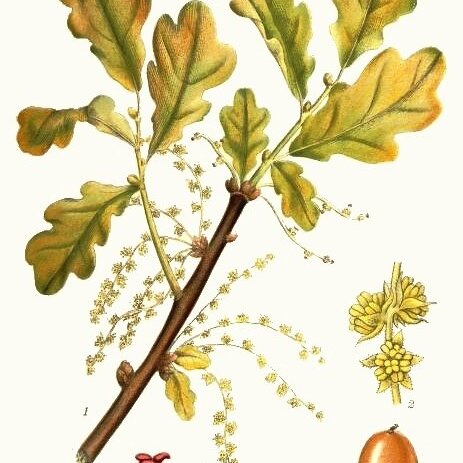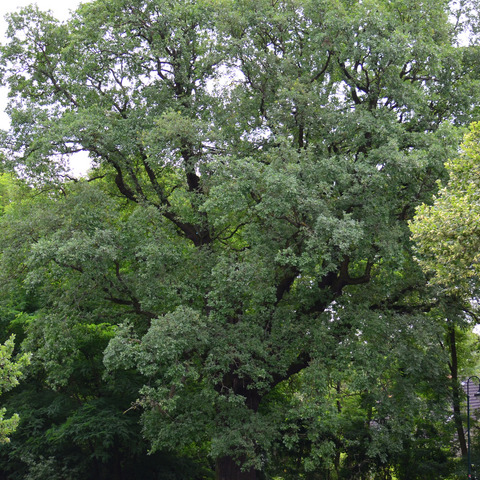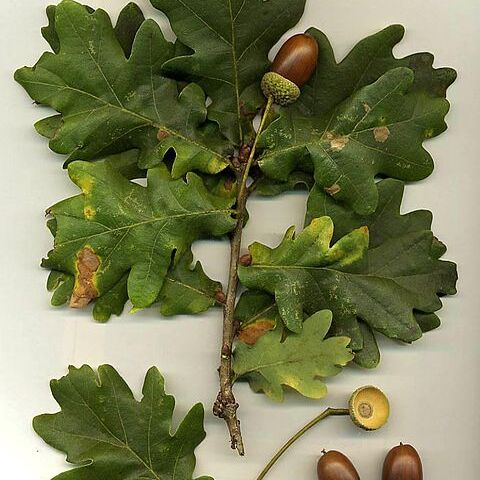Staminate fls in slender, naked catkins, the bracts caducous or none, the cal divided to the base into 6(3–7) segments; stamens 3–12; pistillate fls solitary or in small spikes, each subtended by a bract and surrounded by an involucre of many scales; ovary 3-locular; nut subtended and partly enclosed by the accrescent involucre; trees or shrubs, the fls appearing before the lvs; 2n=24. 400+, cosmop.Our oaks fall into 2 subgenera: in Quercus, the white oaks (spp. 1–12), the fr matures at the end of the first season, the stigmas are sessile or nearly so, the abortive ovules lie at the base of the seed, and the lvs or their lobes are not bristle-tipped. In Erythrobalanus, the red and black oaks (spp. 13–28), the fr matures during the second year, the styles are elongate, the abortive ovules lie at the top of the seed, and in most spp. the lvs or their lobes are bristle-tipped.Most or all of the spp. within each subgenus can and frequently do hybridize, but natural intersubgeneric hybrids are unknown. The following names are believed to apply to hybrids as indicated:Q. ×asheana Little = Q. cinerea × laevisQ. ×atlantica Ashe = Q. cinerea × laurifoliaQ. ×beadlei Trel. = Q. alba × michauxiiQ. ×bebbiana C. K. Schneid. = Q. alba × macrocarpaQ. ×benderi Baen. = Q. coccinea × rubraQ. ×blufftonensis Trel. = Q. falcata × laevisQ. ×brittonii W. T. Davis = Q. ilicifolia × marilandicaQ. ×bushii Sarg. = Q. marilandica × velutinaQ. ×byarsii Sudw. = Q. macrocarpa × michauxiiQ. ×caduca Trel. = Q. cinerea × nigraQ. ×cocksii Sarg. = Q. laurifolia × velutinaQ. ×comptoniae Sarg. = Q. lyrata × virginianaQ. ×cravenensis Little = Q. cinerea × marilandica Q. ×deamii Trel. = Q. macrocarpa × muehlenbergii Q. ×demarei Ashe = Q. nigra × velutinaQ. ×dubia Ashe = Q. phellos × velutina or laevis Q. ×egglestonii Trel. = Q. imbricaria × shumardii Q. ×exacta Trel. = Q. imbricaria × palustrisQ. ×faxonii Trel. = Q. alba × prinoides Q. ×fernaldii Trel. = Q. ilicifolia × rubra Q. ×fernowii Trel. = Q. alba × stellataQ. ×filialis Little = Q. phellos × velutina
Trees or shrubs , evergreen or winter-deciduous, sometimes rhizomatous. Terminal buds spheric to ovoid, terete or angled, all scales imbricate. Leaves: stipules deciduous and inconspicuous (except in Quercus sadleriana ). Leaf blade lobed or unlobed, thin or leathery, margins entire, toothed, or awned-toothed, secondary veins either unbranched, ± parallel, extending to margin, or branching and anastomosing before reaching margin. Inflorescences unisexual, in axils of leaves or bud scales, usually clustered at base of new growth; staminate inflorescences lax, spicate; pistillate inflorescences usually stiff, with terminal cupule and sometimes 1-several sessile, lateral cupules. Staminate flowers: sepals connate; stamens (2-)6(-12), surrounding tuft of silky hairs (apparently a reduced pistillode). Pistillate flower 1 per cupule; sepals connate; carpels and styles 3(-6). Fruits: maturation annual or biennial; cup variously shaped (saucer-to cup-or bowl-to goblet-shaped), without indication of valves, covering base of nut (rarely whole nut), scaly, scales imbricate or reduced to tubercles, not or weakly reflexed, never hooked; nut 1 per cup, round in cross section, not winged. x = 12.
Trees or sometimes shrubs, evergreen or deciduous. Trunk bark deeply splitting or exfoliating longitudinally. Winter buds ovoid-globose, ovoid-conical, or rarely ovoid-ellipsoid; scales few to many, imbricate. Leaves spirally arranged. Stipules extrapetiolar. Male inflorescence pendulous, solitary in leaf axils toward base of branchlets or in paniculate clusters on lateral or subterminal shoots; flower solitary and scattered on rachis; perianth calyciform, 4-7-lobed or more lobed; stamens 4-7 or fewer, filaments slender; staminodes small. Female inflorescences in leaf axils toward apex of branchlets, with few to many cupules; flowers solitary; perianth 5-or 6-lobed; staminodes sometimes present, small; ovary (2-or)3(or 4)-loculed; stigmas dilated or ligulate, lining inner faces of styles. Cupules solitary; bracts imbricate, scalelike, linear, or conical, adherent, prostrate, or reflexed. Nut 1 per cupule. Germination hypogeal.
Deciduous, semi-deciduous or evergreen trees or occasionally shrubs, monoecious. Indumentum, when present, of stellate hairs. Leaves alternate, toothed, lobed or occasionally entire, those of deciduous species often coloured in autumn. Flowers produced before or with new leaves (deciduous species). Male flowers in pendulous catkins, often rather sparse; perianth of mostly 5 or 6 narrow, acute sepals, shortly fused at base; stamens 4–6 (–12). Female flowers solitary, paired or in small spikes from leaf axils; perianth rudimentary, styles usually 3. Fruit a 1-seeded nut (acorn) maturing in 1 or 2 years, partially enclosed in a cupule of fused or partly fused basal scales.
Deciduous or evergreen trees or rarely shrubs, generally with rough fissured bark. Bud scales numerous. Lvs usually short-petiolate, usually toothed to deeply lobed, rarely entire. Fls anemophilous. ♂ fls in slender pendulous catkins; bracts caducous; perianth (4)-6-(7)-lobed; stamens (4)-6-(12). ♀ fls 1-many in catkins; involucre (cupule) surrounding each catkin or individual solitary fl. Ovary 3-(6)-celled; styles short or elongate. Fr. a nut (acorn), usually subglobose to ellipsoid or oblong, invested to varying degrees but never enclosed by woody cup. Involucral scales numerous, imbricate or connate into concentric rings. Seed round in transverse section.
Trees or shrubs; leaves alternate, simple, petiolate, blades entire, toothed, or lobed, persistent or deciduous, stipules associated with the buds, ligulate, often caducous; flowers monoecious; staminate flowers in flaccid pendulous aments, the perianth about 5-lobed, stamens 5 to 10, free; pistillate flowers solitary or clustered, subsessile or peduncled, enclosed in an involucre of numerous flat scales, the peri-anth 6-lobed, ovary 3-carpellate, 1-celled, ovules 6 (5 abortive), styles 3, short; fruit a nut (acorn), 1-seeded, partly enveloped by an involucre (cup) of flat or basally thickened scales, maturing in 1 or 2 seasons.



